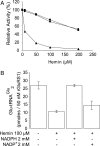Regulation of a glutamyl-tRNA synthetase by the heme status
- PMID: 17360620
- PMCID: PMC1805545
- DOI: 10.1073/pnas.0611611104
Regulation of a glutamyl-tRNA synthetase by the heme status
Abstract
Glutamyl-tRNA (Glu-tRNA), formed by Glu-tRNA synthetase (GluRS), is a substrate for protein biosynthesis and tetrapyrrole formation by the C(5) pathway. In this route Glu-tRNA is transformed to delta-aminolevulinic acid, the universal precursor of tetrapyrroles (e.g., heme and chlorophyll) by the action of Glu-tRNA reductase (GluTR) and glutamate semialdehyde aminotransferase. GluTR is a target of feedback regulation by heme. In Acidithiobacillus ferrooxidans, an acidophilic bacterium that expresses two GluRSs (GluRS1 and GluRS2) with different tRNA specificity, the intracellular heme level varies depending on growth conditions. Under high heme requirement for respiration increased levels of GluRS and GluTR are observed. Strikingly, when intracellular heme is in excess, the cells respond by a dramatic decrease of GluRS activity and the level of GluTR. The recombinant GluRS1 enzyme is inhibited in vitro by hemin, but NADPH restores its activity. These results suggest that GluRS plays a major role in regulating the cellular level of heme.
Conflict of interest statement
The authors declare no conflict of interest.
Figures





Similar articles
-
Cellular levels of heme affect the activity of dimeric glutamyl-tRNA reductase.Biochem Biophys Res Commun. 2011 Feb 4;405(1):134-9. doi: 10.1016/j.bbrc.2011.01.013. Epub 2011 Jan 8. Biochem Biophys Res Commun. 2011. PMID: 21219871
-
A tRNA(Glu) that uncouples protein and tetrapyrrole biosynthesis.FEBS Lett. 2005 Nov 21;579(28):6383-7. doi: 10.1016/j.febslet.2005.09.100. Epub 2005 Oct 25. FEBS Lett. 2005. PMID: 16271718
-
Redox status affects the catalytic activity of glutamyl-tRNA synthetase.Biochem Biophys Res Commun. 2010 Jul 16;398(1):51-5. doi: 10.1016/j.bbrc.2010.06.031. Epub 2010 Jun 10. Biochem Biophys Res Commun. 2010. PMID: 20541532 Free PMC article.
-
Transfer RNA and the formation of the heme and chlorophyll precursor, 5-aminolevulinic acid.Biofactors. 1990 Oct;2(4):227-35. Biofactors. 1990. PMID: 2282139 Review.
-
Glutamyl-tRNA sythetase.Biol Chem. 1997 Nov;378(11):1313-29. Biol Chem. 1997. PMID: 9426192 Review.
Cited by
-
Engineering Corynebacterium glutamicum to produce 5-aminolevulinic acid from glucose.Microb Cell Fact. 2015 Nov 17;14:183. doi: 10.1186/s12934-015-0364-8. Microb Cell Fact. 2015. PMID: 26577071 Free PMC article.
-
Gene expression profiling in Entamoeba histolytica identifies key components in iron uptake and metabolism.PLoS One. 2014 Sep 11;9(9):e107102. doi: 10.1371/journal.pone.0107102. eCollection 2014. PLoS One. 2014. PMID: 25210888 Free PMC article.
-
Physiological and transcriptomic analyses of a yellow-green mutant with high photosynthetic efficiency in wheat (Triticum aestivum L.).Funct Integr Genomics. 2018 Mar;18(2):175-194. doi: 10.1007/s10142-017-0583-7. Epub 2017 Dec 21. Funct Integr Genomics. 2018. PMID: 29270875
-
Construction, analysis and validation of co-expression network to understand stress adaptation in Deinococcus radiodurans R1.PLoS One. 2020 Jun 24;15(6):e0234721. doi: 10.1371/journal.pone.0234721. eCollection 2020. PLoS One. 2020. PMID: 32579573 Free PMC article.
-
Prokaryotic Heme Biosynthesis: Multiple Pathways to a Common Essential Product.Microbiol Mol Biol Rev. 2017 Jan 25;81(1):e00048-16. doi: 10.1128/MMBR.00048-16. Print 2017 Mar. Microbiol Mol Biol Rev. 2017. PMID: 28123057 Free PMC article. Review.
References
-
- Ibba M, Söll D. Genes Dev. 2004;8:731–738. - PubMed
-
- Park SG, Ewalt KL, Kim S. Trends Biochem Sci. 2005;30:569–574. - PubMed
-
- Ryckelynck M, Giege R, Frugier M. Biochimie. 2005;87:835–845. - PubMed
-
- Feng L, Tumbula-Hansen D, Min B, Namgoong S, Salazar J, Orellana O, Söll D. In: Aminoacyl-tRNA Synthetases. Ibba M, Cusack S, editors. Georgetown, TX: Landes; 2005. pp. 314–319.
Publication types
MeSH terms
Substances
LinkOut - more resources
Full Text Sources
Molecular Biology Databases
Miscellaneous

